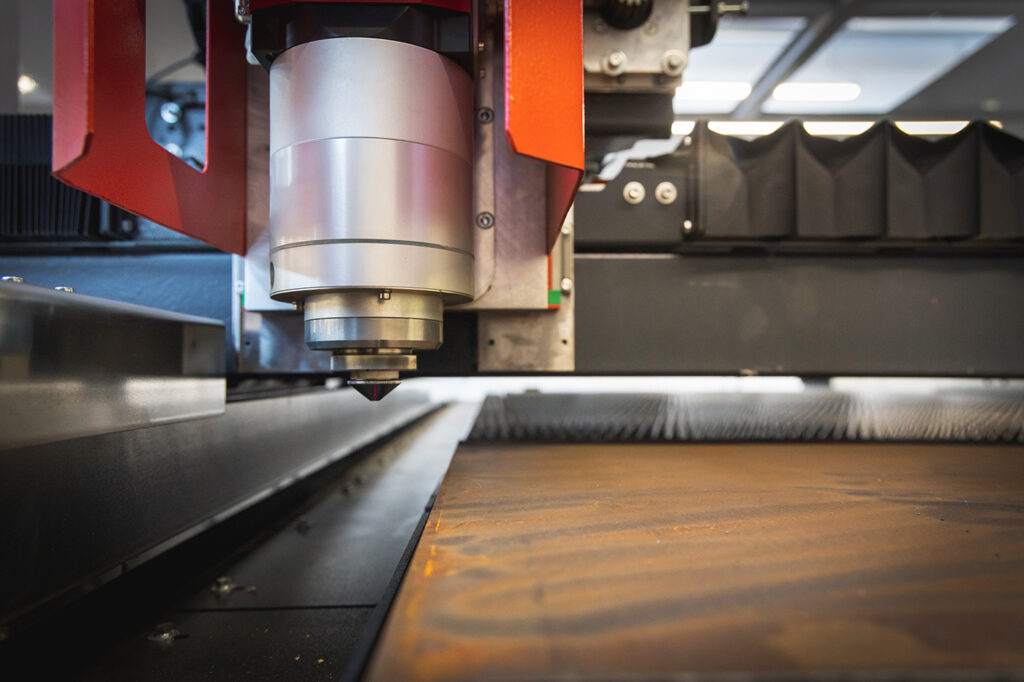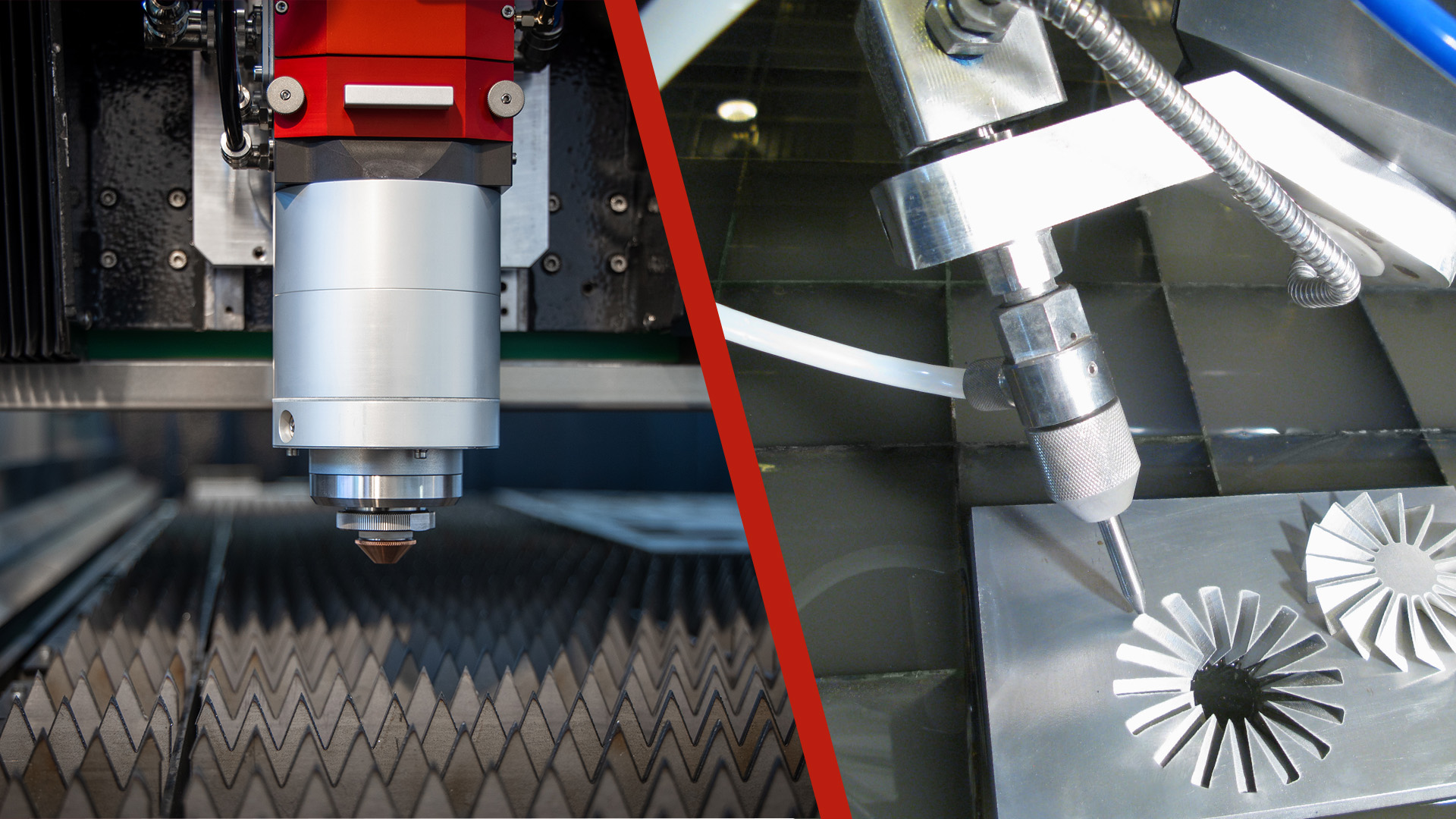Do you want to purchase a metal cutting system but cannot device between waterjet cutting and fibre laser cutting? Both cutting systems have improved over the years to meet the needs of the industry and become increasingly competitive. Compared to traditional cutting techniques, today fibre laser and waterjet machines undoubtedly offer many advantages. But which of the two systems guarantees the greatest efficiency?
How do waterjet and fibre laser cutting work
To find out which metal cutting machine is the most suitable one for your company, it is important to understand how the two processing systems work. Let’s take a look at them in detail:
Waterjet metal cutting: how it works
Waterjet cutting is a cold cutting system based on the use of a flow of water at a very high pressure. The jet of water that comes out of a small hole erodes the material it encounters, resulting in the desired cut. Often, an abrasive material is added to the water, such as aluminium oxide or garnet, in order to improve the quality of the cut.

Advantages and disadvantages of waterjet cutting
Waterjet cutting can be used on a wide range of materials and it is therefore very useful to process pieces of composite materials. The cold cutting technique does not produce unwanted deformation of the material and, if abrasive material is added, good cutting quality is achieved. Finally, waterjet cutting is also effective on very high thicknesses.
Among the disadvantages of waterjet cutting, the first one is definitely its processing efficiency. Given its low cutting speed, production times are considerably longer compared to laser cutting. It is also necessary to take into account that when cutting very thick workpieces, a slightly conical pattern is obtained from top to bottom, due to the loss of water power. On the other hand, the pressure of the water jet is such that it is not suitable for processing very small metal parts.
Another disadvantage of waterjet cutting concerns the processing conditions. Waterjet cutting systems are very noisy. The operator must therefore wear hearing protection and, if abrasive material is used, also protective glasses to avoid eye damage due to sandblasting.
Finally, a waterjet machine uses large quantities of water and abrasive materials which must then be disposed of, thus increasing production costs.
Fibre laser metal cutting: how it works
Optical fibre laser cutting uses a high intensity laser beam emitted by a source (laser seed) and amplified through optical fibre “pumped” by diodes. The beam emitted has an infinitesimal focal diameter, with an intensity 100 times greater than the CO2 laser. As it hits the material, the laser beam produces an extremely precise cut, maintaining very high quality even on large production quantities.

Advantages and disadvantages of fibre laser cutting
Fibre laser cutting is the most efficient metal cutting system on the market. Flawless cutting precision goes hand in hand with its high processing speed, resulting in an efficiency up to 30% higher than other techniques. The reduced wavelength of the fibre laser beam means that even conductive metals, such as brass and copper, can be processed with high quality results. The diameter equal to that of a hair guarantees extreme precision even when processing very small workpieces. Moreover, fibre laser cutting is environmentally friendly because it has low consumption, produces no waste and the smoke generated can be easily removed using a ventilation device.
One of the disadvantages of fibre laser cutting is the generally higher cost of the machinery, which is however largely compensated for in the medium and long term by the reduced production costs.
Which system should you choose between waterjet and fibre laser?
Considering the pros and cons of the two cutting systems, you can choose the most suitable one based on your company’s needs:
If you need to cut workpieces that are more than 50 mm thick and a wide range of materials (such as stone, ceramics, plastic, etc.), you can choose a waterjet system.
If you need to cut metals and sheet metal, process even small parts and workpieces that are up to 50 mm thick, fibre laser cutting is much more efficient. It also guarantees a clean and quiet workplace, reduced production times and costs and environmentally friendly processing.
Cutlite Penta fibre laser cutting systems: more power and versatility
Cutlite Penta designs and develops optical fibre laser cutting systems that offer very high power and processing quality. Entirely Made in Italy, Cutlite Penta laser cutting machines were the first in Italy and Europe to reach a cutting power of 30 kW. The EVO 3 cutting head also guarantees maximum flexibility when cutting pipes and sheet metal. Among the advantages offered by Cutlite products:
- Maximum power and speed performance
- Very high cutting quality
- Linear motors on each system
- Automatic loading and unloading system
- Customised configurations
- Possibility of working on large formats
- Customised assistance
- Proprietary technology and Made in Italy quality
Discover fibre laser cutting machinery on our website or contact us for information.
